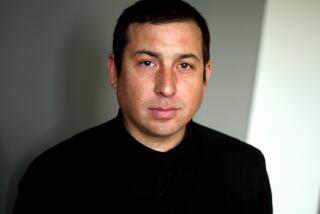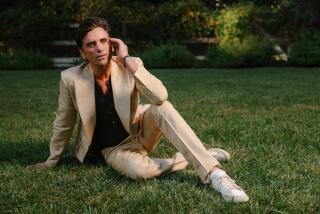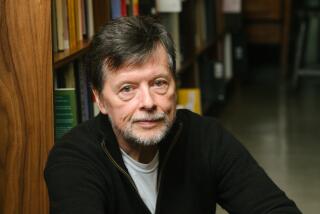After Learning History, He’s a John Wayne in Name Only
- Share via
The way the story got handed down through the family, the newborn’s sister turned to their father and said, “Dad, I think we should name him John Wayne.”
If you were living in Orange County in the mid-60s, the heroes didn’t come much bigger than the Duke--a local resident and already a living legend. So on that day in 1966, the boy became John Wayne Haug.
Growing up in Orange County, Haug was proud of his namesake. “I loved watching his movies,” he told me last week in the small office he uses while finishing his graduate studies at Cal State Fullerton. “My dad and I used to impersonate him. My mother called me John Wayne all the time. I was proud of it and I told people it made me feel special. My father gave me two paintings of him; one was the Newport Beach John Wayne and the other was the cowboy John Wayne. I had them up in my room for years.”
Haug grew up a patriot and a war buff who loved American history. Learning that he was perhaps one-sixteenth Cherokee only spiced his love of history; when his boyhood friends played “cowboys and Indians,” Haug obligingly played the Indians.
Now 28, those days seem now long, long past. In the last few years, while combining dual undergraduate majors in photography and anthropology, Haug has been on a journey, of sorts. It began as a scholastic pursuit but became a personal odyssey that tapped into what he had thought was but a distant part of his heritage: his Native American ancestry.
For his graduate degree thesis, Haug prepared a 30-minute film on the life of a Tiwa Pueblan named Felix Montoya, now living in Los Angeles. Through Montoya’s life and through contacts with other Native American historians, Haug found himself immersed in its culture and belief system. Along the way, he says, he became virtually overwhelmed with his sense of connection to it.
“I don’t want to use the word ‘religion,’ because it is not,” Haug says. “I have a connection with the earth. I see the earth as my mother, because that is where all life comes from.”
Even as he realized the personal impact his studies were having on him, Haug says he labored to keep that separate from the scholastic part of his work. But even as his spiritual connection with Indian heritage soothed him, his academic pursuits angered him.
He began to see, he says, that everything he learned in school about Native Americans was fraudulent. He had been taught, he says, that “the Spanish missions were these great wonderful things and part of our history, when in reality they are to me the equivalent of the Japanese internment camps. They (the Spaniards) enslaved them and, particularly in the 1500s when the conquistadors came into the Southwest, the Indians were given the option of being Christianized or being killed. I said, I have to learn the truth for myself.”
His search, Haug says, inevitably forced him to come to grips with the man for whom he was named. After all, he asked himself, how could he continue being proud of the man who forged much of his Hollywood celebrity as an Indian fighter?
As it has turned out, Haug couldn’t.
The “flash point,” Haug says, was a column I wrote several months ago in which I longed for what John Wayne seemed to represent--open, honest simplicity and personal toughness.
That column prompted Haug to write a letter to me that, he said as we talked last week, “just flowed from me without having to think about it.”
In the letter, Haug wrote: “The films Wayne made were based in part upon true historical events, which Hollywood then twisted into a nasty stereotype that persists today. . . . There are ‘white folk’ in this country to this day that still believe ‘the only good Indian is a dead Indian,’ a phrase which The Duke helped to perpetuate.”
He went on to write: “The genocide continues today. Maybe not with guns and horses, but with pollution, desecration of sacred burial sites and thought (advertising and teaching of European history in our schools). So long as people like John Wayne and Columbus are recognized as heroes for their good deeds and discoveries, the killing of Indian people and their culture will continue in one form or another.”
During Columbus Day observances this week, Haug will wear a purple armband. If anyone asks why, he says, he will politely give them his view on Indian history in America. “I’ll say I’m glad you asked and take the time to teach them what I’ve been taught and encourage them to go out and learn.”
I asked Haug if he has been able to make peace with his namesake. An acquaintance of Wayne’s, he said, told him that the “real” John Wayne was a good-hearted sort. “The way I look at him now is just that,” Haug says. “I say, ‘OK, maybe as a person I didn’t know him, I don’t know much about him, maybe I should read a book about him. I won’t judge him as a person. As a character he played, I judge him just about as destructive as any Adolf Hitler or any government that takes the original inhabitants of that country and slowly kills them off.”
Dana Parsons’ column appears Wednesday, Friday and Sunday.
More to Read
The biggest entertainment stories
Get our big stories about Hollywood, film, television, music, arts, culture and more right in your inbox as soon as they publish.
You may occasionally receive promotional content from the Los Angeles Times.










